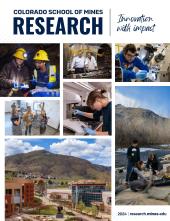Mines leads the way in discovering untapped energy potential of geologic hydrogen


By Jenn Fields, Special to Mines Research Magazine
Hydrogen has been promising as a clean-burning fuel that could power high-carbon sectors of the economy, such as aviation and long-distance shipping, but current methods for producing it are expensive and energy intensive. However, recent research suggests that vast quantities of geologic hydrogen could be tapped from underground reservoirs to meet future alternative energy needs, and Mines researchers are leading the way in finding this resource.
Geophysicists Mengli Zhang and Yaoguo Li are working with the U.S. Geological Survey as part of a joint industry program to develop exploration techniques to find hydrogen trapped underground. Industry partners including BP, Chevron, Petrobras and several start-up companies are supporting the research, which seeks to develop surface and subsurface exploration tools to locate hydrogen reserves or find areas to enhance hydrogen generation and increase yield.
Li met with USGS research geologist Geoffrey Ellis in 2022 to learn more about the agency’s efforts at understanding the geologic formations that create ideal conditions for an underground reservoir of hydrogen, or “hydrogen system,” much in the same way that the petroleum system guides geologists’ understanding of where oil and gas occur underground.
Ellis and his USGS colleagues had come up with some stunning hydrogen reservoir estimates. “From the source rock, there is potential to power human life for hundreds of years,” Zhang said. “It’s one reason why geologic hydrogen is getting so much attention.
Zhang and Li are now jointly leading a geologic hydrogen consortium with Ellis, and the Mines researchers are using their geophysics expertise to develop directly deployable subsurface exploration tools.
“We would like to share our understanding and knowledge about how geologic hydrogen is generated, how it accumulates in reservoirs and what is the indicator at the surface—there is work on that because surface exploration can be relatively inexpensive,” Zhang said. “For the subsurface, we would like to provide the knowledge about what geologic settings and structures have high potential for geologic hydrogen reservoirs to form.”
Zhang said more research is needed to know exactly where the reserves are, but the U.S. appears to hold a lot of potential hydrogen. “The ‘younger continent’ has more potential to have reserve,” Zhang said.
One challenge the researchers face is that in many underground environments, hydrogen is easily absorbed in the surrounding rocks through biological and chemical reactions. “For geologic hydrogen, the period to produce it is relatively short—decades instead of hundreds or millions of years,” she said. “Compared to hydrocarbon, which is produced slowly and is stable, geologic hydrogen is quicker to produce but unstable. So the difficulty is that hydrogen easily reacts with the environment—it can be quickly consumed by the environment.”
Despite the challenges, the emerging geologic hydrogen community is optimistic. The models Zhang and Li are building, using geophysical and geological data and AI to identify and characterize geologic hydrogen reserves, hold the keys to exploration. But their models also explore options for stimulating geologic hydrogen if they can locate iron-rich source rocks.
“Maybe there is not enough of the naturally occurring hydrogen, or maybe the concentration and volume is not enough to achieve the economic level,” Zhang explained as a possibility. “If we have the ambitious goal that we totally change to low-carbon energy solutions, the economic level is what we need to consider, and if hydrogen is $2 but gas is $1, then it is not good enough. Then we come to another level: Can we stimulate the generation of geologic hydrogen to be competitive with oil and gas, to make the price lower?”
The price matters—it’s what has held hydrogen back as a fuel, despite holding the power to launch a rocket into space. When burned in a fuel cell, hydrogen’s only emissions are heat and water, but much of the hydrogen in use for fuel now is a carrier drawn partly from natural gas. Zero-carbon “green hydrogen” uses significant amounts of wind or solar power to produce hydrogen from water. As a resource, geologic hydrogen would require minimal processing, making it an economically viable alternative to the fuel’s current challenges.
Zhang said Mines provides the perfect foundation for their research in this exciting field. “The geologic hydrogen situation, it’s a combination of the mineral system and the hydrocarbon system. What does Mines bring? One hundred and fifty years of mineral exploration and mining expertise. We have the mining, petroleum, geology and geophysics departments.These departments all provide the necessary elements for expertise in geologic hydrogen. To my knowledge, none of the other universities have this depth of knowledge like Mines.”



